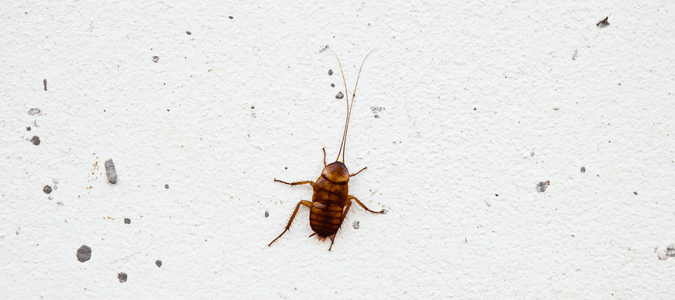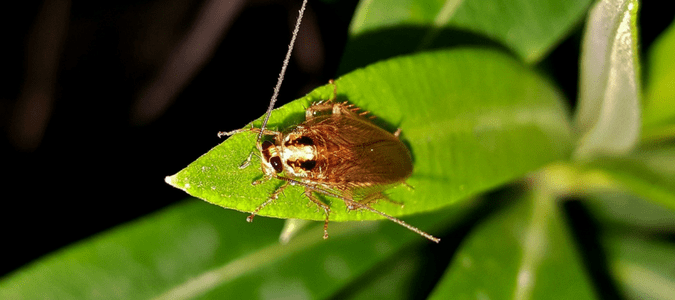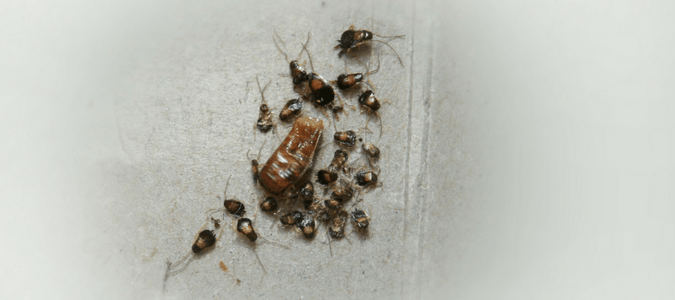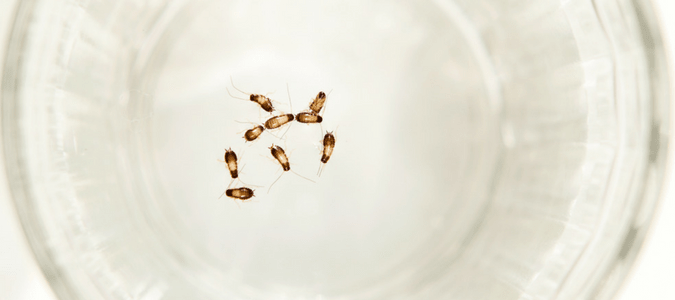
If you’ve never come face to face, or face to toe, with a cockroach before, consider yourself lucky. These insects are one of the most common household pests. If you haven’t found one inside your home yet, chances are that you will eventually come across one sooner rather than later. Unfortunately, it’s not just one type of cockroach you can encounter. There are a variety of species to look out for that come in different sizes and colors, too.
Take tiny roaches, for example. Both smaller in size and different in color, these cockroaches can puzzle even the most savvy homeowner. If you want to learn more about these small creatures that can cause a big disruption in your household, keep reading for information about types of roaches, what baby roaches look like what to do when you run across these creatures in your home, and most importantly, how to get rid of these pesky pests.
Most cockroaches are tropical or subtropical, and as a result, tend to live outdoors. Despite this, though, some species have adapted well to living with humans and find their way into our homes. If you do find one in your home, don’t assume it’s because your home is dirty, as that is a common misconception. While it’s true that cockroaches thrive in clutter-filled, grimy spaces, they have also been known to invade even the cleanest, well-organized homes and spaces, too.
For the species that make their way into your home, they enter through boxes, bags, used furniture and dried pet food, too. They can also make their way indoors via open doors and windows, through water or sewage pipes and over electrical lines. These pests tend to make their home in warm, dark, humid spaces, and often reside in cracks around, under or inside cupboards and cabinets, especially those in your kitchen or bathroom.
There are approximately 3,500 species of cockroaches worldwide, but only 55 are known to live in the United States. It’s a small percentage in comparison, and even a smaller number that we find in Texas and other southern states: just five species which are known to live in homes and buildings. Other types are either not found in this part of the country or live and breed outdoors.
Regardless of the species, all cockroaches develop by gradual metamorphosis and all cockroaches have three life stages, including egg, nymph and adult. When the reproduction phase begins, adult females produce small, bean-shaped egg capsules to be dropped or glued to a surface soon after they are formed. We’ll talk about a nymph’s characteristics a bit later, but first, let’s discuss the five different types of creepy crawlies you might find in and around your home.

Types Of Roaches Found In And Around Homes
The five species that are commonly found inside are the German cockroach, the brown-banded roach, the American cockroach, the Oriental roach and the smokey-brown cockroach.
German Cockroaches
What are German roaches? The German cockroach, shown above, is the smallest cockroach species, measuring just ½ to ⅝ of an inch in length. Don’t let its small size fool you, though. This cockroach species is one of the most prevalent species of this pesky pest. Light brown in color, you can recognize this species by the two dark stripes that run lengthwise along its head. While its wings are fully developed, this species of cockroach rarely flies. Immature German cockroaches are even smaller than the adults, appear darker in color and don’t have wings.
Unlike other types of roaches, the German cockroach doesn’t attach or leave her eggs on any surface. Instead, this species carries the egg capsules on their abdomens until the eggs are ready to hatch.
German cockroaches can be found in all types of buildings, including homes, apartments, condominiums and commercial food establishments. You can also see German roaches outside. Similar to other cockroach species, the German cockroach enters these spaces through dried foods, furniture or through cracks and crevices in the building’s structure. They also make their home in dark shelters near moisture, typically in the kitchen or bathroom.
Brown-Banded Cockroach
Similar to the German cockroach, the brown-banded roach is very tiny, ranging from just ½ to ⅝ inches in length. It also ranges in color, from light gold to glossy dark brown; it has yellow bands that can be seen on the base of the wings and along the abdomen, which are more pronounced on nymphs than adults. Unlike the German cockroach, though, this cockroach species is an active flyer and the males are known to fly rapidly when disturbed.
This species is most commonly found in homes, apartments, hotels and large spaces, including hospitals and nursing homes. Within these spaces, they tend to hide in dark, small spaces, like behind picture frames or in cabinets or closets. Unlike their counterparts, though, brown-banded roaches aren’t drawn to humid spaces, but instead occupy drier rooms within the building. As for their diet, they prefer starchy foods and require less water than other species.
American Cockroach
The American cockroach is much larger than the two previous species, growing to be 1 ½ to 2 inches in length. Its color is a reddish-brown and both male and female roaches have fully developed wings, though they rarely fly. Like most other roach species, the American female cockroach drops her egg capsule off within one to two days after it is formed, typically leaving it near water.
This species is one that has become well-adapted to living with humans, as most homes and commercial buildings provide the type of shelter it desires and an abundant supply of food. And because this species favors dark, humid environments, homeowners will typically find them in kitchens, bathrooms, basements, sewers or in crawl spaces underneath the home or building.
Oriental Cockroach
This cockroach species is just a bit smaller than the American cockroach, with females measuring roughly 1 ¼ inches long and males reaching just one inch in length. Both male and female oriental cockroaches have wings, though neither sex can fly. Their color is dark, with either a glossy brown or dark appearance.
Oriental roaches are usually noticed in the spring while they mate. Around this time, they typically move outdoors and remain there during the summer months. During the warmer months, this species likes to make their home in lawns, compost piles, flower beds and landfills. This species also prefers moist, humid environments and can be found in kitchens, drains and dark, damp spaces, including basements. Once the heat subsides in the fall, however, they move indoors to spend the winter.
Smokey-Brown Cockroach
As you might expect from its name, the smokey-brown cockroach is either a very dark brown or black. Like other types of roaches, both males and females have wings and are capable of flying or gliding. This species prefers the outdoors when making their home, gravitating towards leaf litter, trash piles and other areas with abundant organic matter. If found indoors, it’s most likely they were brought in via firewood during the colder months.

What Does A Baby Cockroach Look Like?
As we mentioned above, most female adults drop their eggs on a surface to wait for it to hatch, many doing so just days after the egg is formed.
Nymph cockroaches emerge on the surface once the egg hatches. Though they share similar features as their adult counterparts, nymphs are smaller and don’t have fully developed wings. A nymph’s body is flattened and long, with prickly legs that allow them to run fast and squeeze into tiny spaces and crevices. Immature roaches typically have a different coloring, too, compared to adults that belong to the same species.
Before fully maturing into an adult male or female cockroach, a nymph will molt several times. Depending on the species, its food and water sources and its environmental conditions, the time required to complete a life cycle can range from two months to almost three years.

The Baby German Cockroach
Baby German cockroaches are distinct they are the only species where the female carries its eggs until it hatches, doing so on its abdomen. Furthermore, this species produces more eggs per capsule compared to other species, so it can multiply more quickly. While the time it takes to develop from nymph to adult can vary amongst species, a German nymph can develop in as little as two months. Because of these factors, this species can cause an infestation faster than most other types of roaches.
Compared to adults in this species, baby German cockroaches can be darker brown, even black in color, smaller and appear to have a more oval shape.

Baby Roaches In Bathroom: What Can You Do?
If you spot a small cockroach in your bathroom, it could be classified within one of three categories: a nymph, a brown-banded cockroach or a German cockroach. The latter two can be mistaken for nymphs because of their small size. Regardless of the species, though, it’s important to know why they are congregating in your bathroom, or similarly, your kitchen, in the first place.
Where do roaches hide? As we mentioned above, most cockroach species are drawn to dark, humid spaces. That’s why you’ll typically find them under your sink and around the plumbing in your cabinets. Similarly, it’s not unheard of to find them in your bathtub or shower, as many can hide in the drain or in the cracks and crevices within the walls.
How To Get Rid Of Small Cockroaches
Riding your home of tiny cockroaches should be approached the same way you should approach doing so for large cockroaches. The first step you’ll want to take is to clean your home, especially your kitchen and bathroom. Exposed food or water can attract cockroaches, so removing anything that could entice roaches to stick around can help deter them from entering your home. If you do have food on the counter, seal it in airtight containers. In the same regard, be sure to clean up pet food and water bowls, especially overnight, since cockroaches are nocturnal and can feast on this bounty while everyone in your home is fast asleep.
You’ll also want to take steps to ensure your home is clean overall. Take the time to vacuum both around and under the furniture in your home and be sure to occasionally check under pillows and seats for any small food particles that might be hidden away. Since vacuuming can remove eggs and tiny cockroaches you might not see, this is a necessary step to both remove cockroaches and keep them from multiplying. If that doesn’t work, there is a wide variety of baits and other traps to choose from to eliminate these unwelcome visitors.
ABC Can Keep Your Home Roach-Free
While you can take steps to make your home less attractive to roaches, your best bet to control an infestation or prevent one from occurring, is to call your local pest control company. The experienced team at ABC Home & Commercial Services is well-equipped and able to tackle any size problem and any species of cockroach, too. Our technicians will inspect your home and create a customized plan that works best for you and your home so that you don’t have to worry about an unexpected encounter with these pesky pests.
